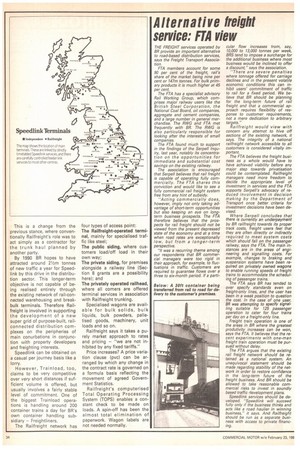Speedlink's support from hauliers
Page 35

Page 36

If you've noticed an error in this article please click here to report it so we can fix it.
SPEEDLINK is the most obvious competitor to road transport. But this, too, has a strong intermodal side.
This Railfreight service claims: "Some of the keenest supporters of this new concept are the road hauliers themselves. They know it makes sense to let Speedlink trains do the long hauls while they use their own vehicles for the short journeys and door-to-door distribution. The road fleets are used more cost-effectively, which is good news for the road hauliers."
In partnership with independent road distribution specialists, Speedlink offers companies without sidings a complete road/rail package. This can include warehousing, transhipment, break bulk, order picking, stock control and timed road deliveries from the 191 road/rail depots throughout the United Kingdom. Including private sidings, there is a total of more than 600 terminals in the network. Speedlink says it can deliver to most places in the UK within 24 hours.
"By utilising road transport on only the shorter local distances," it says, "Speedlink is more economical in terms of fuel consumption, less vulnerable to future uncertainties arising out of fuel shortages, escalating prices, and restrictive legislation."
Potential clients are helped to compare road and rail distribution options by means of a free consultancy service. Requirements can be examined by the Distribution Analysis Facility — DISTAF — developed by BR's Research and Development Division, Derby.
What are termed "super truck-load" rail vehicles — up to 54 tonnes and 110 cubic metres — are claimed to give highly cost-effective trunk haulage, particularly on movements over 125 miles.
Speedlink is the spearhead of the new drive Railfreight is making in the consumer goods distribution market. What is termed Railfreight Distribution is a concept providing manufacturer or importer with a railbased distribution system. Speedlink Distribution adapts to changing patterns of demand. Short-notice changes, holidays and peak demands are handled by the contract manager for the complete package.
A key element is that Railfreight is prepared to take the lead as principal for the whole distribution package. An overall scheme can be put together, priced, sold and controlled by Railfreight as an integrated total operation. This is a change from the previous stance, where conventionally Railfreight's role was to act simply as a contractor for the trunk haul planned by another party.
By 1990 BR hopes to have attracted around 21/2m tonnes of new traffic a year for Speedlink by this drive in the distribution sector. This longer-term objective is not capable of being realised entirely through the existing network of rail-connected warehousing and breakbulk terminals. Therefore Railfreight is involved in supporting the development of a new super grid of purpose-built, railconnected distribution complexes on the peripheries of main conurbations in conjunction with property developers and freighting interests.
Speedlink can be obtained on a casual per journey basis like a lorry.
However, Trainload, too, claims to be very competitive over very short distances if suf
ficient volume is offered, but usually involves a fairly stable level of commitment. One of the biggest Trainload operations is handling around 200 container trains a day for BR's own container handling subsidiary — Freightliners.
The Railfreight network has four types of access point:
The Railfreight-operated terminal, mainly for specialised traffic like steel; The public siding, where customers load/off load in their own way; The private siding, for premises alongside a railway line (Section 8 grants are a possibility here); and
The privately operated railhead, where all corners are offered terminal services in association with Railfreight trunking.
Specialised wagons are available for bulk solids, bulk liquids, bulk powders, palletised goods, machinery, unit loads and so on.
Railfreight says it takes a purely market approach to rates and pricing — "we are not inhibited by any fixed tariffs."
Price increases? A price variation clause (pvc) can be arranged by which any change in the contract rate is governed on a formula basis reflecting the movement of agreed Government Statistics.
Railfreight's computerised Total Operating Processing System (TOPS) enables a constant check to be made on loads. A spin-off has been the almost total elimination of paperwork. Wagon labels are not needed normally.




















































































